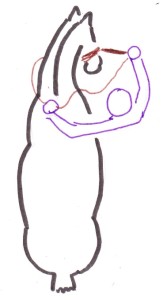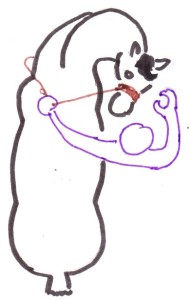Your horse seeks the most peaceful option
A horse that cannot find peace will either stop trying or become difficult.
The easiest way for your horse to learn how to respond to your aids is to
remove the stimulus (aid) for every tiny try and allow your horse time to think.
Do not wait to achieve your end goal before you release the aid –
your horse may never work out what to do .
Establish an Emergency Braking System
Teach this from the ground first
It is always good to have a way of managing a troubled horse to disable its ability to run off or throw you off, and to give you time to dismount. The following is one way to teach an Emergency Braking System (EBS).
You need the horse to be very light and responsive to this aid under quiet circumstances if you hope it to be effective under stress. Pay particular attention to getting the start of the bend responsive – if you cannot get it started it, you are unlikely to get the rest!
Step 1
Stand beside your horse at about the girth area (near where you would sit).
![]() Stay in the same position relative to the horse.
Stay in the same position relative to the horse.
This is easily done if you hang your nearest arm on his back. You can use this hand to hold the rein buckle.
![]() Your other hand is going to take the rein, step-by-step, in a large arc
Your other hand is going to take the rein, step-by-step, in a large arc
see Diagram 1.
Diagram 1 Diagram 2 Diagram 3
Step 2
Take the slack out of the inside rein until you can feel some resistance.
See Diagram 2. The inside rein is the one on the side you are standing e.g. right rein when you are on the horse’s right (off) side.
![]() Keep your hand position fixed while the horse experiments.
Keep your hand position fixed while the horse experiments.
Step 3
Wait for a momentary release of the pressure on the rein, and then drop the rein out of your hand. See Diagram 3
![]() Do not allow the horse to pull the rein through your hand – this would teach the horse to snatch the rein from you
Do not allow the horse to pull the rein through your hand – this would teach the horse to snatch the rein from you
Step 4
Move to the other side of the horse and repeat the process with the other rein.
from Step 1.
![]() By changing sides after every try, your horse will more quickly work out how to remove the pressure.
By changing sides after every try, your horse will more quickly work out how to remove the pressure.
Diagram 4 Diagram 5
![]() When the horse brings his nose easily off the pressure you can ask for more bend by taking up the slack again from the released position. See Diagrams 4 and 5
When the horse brings his nose easily off the pressure you can ask for more bend by taking up the slack again from the released position. See Diagrams 4 and 5
![]() Again, feel for some resistance and fix your hand position.
Again, feel for some resistance and fix your hand position.
If necessary, drift with your horse to stay in the same position relative to him.
If he moves a lot, you may have asked to strongly with the rein, or he may just need to experiment.
![]() Swap sides after each try
Swap sides after each try
![]() Eventually, your horse should be able to bring his neck around to his girth (depending on how supple his muscles are), See Diagram 6.
Eventually, your horse should be able to bring his neck around to his girth (depending on how supple his muscles are), See Diagram 6.
![]() You may need to step back towards his hindquarters to give his head some space at the girth.
You may need to step back towards his hindquarters to give his head some space at the girth.
You can maintain the length of rein with the top hand while you caress his head with the other. See Diagram 6
Diagram 6
Repeat the process while mounted:
![]() Start at the halt and when the horse bends easily to the aid, bend him until he stops and relaxes from a walk, trot or canter.
Start at the halt and when the horse bends easily to the aid, bend him until he stops and relaxes from a walk, trot or canter.
Be smooth with your aids, particularly at canter (so as not to tip him over).
![]() You can take the slack out of the reins by lifting them high with one hand (the ‘buckle hand) while the other (rein hand) reaches for a short contact.
You can take the slack out of the reins by lifting them high with one hand (the ‘buckle hand) while the other (rein hand) reaches for a short contact.
The ‘buckle’ hand can now also hold the mane or saddle for security.
![]() Take your ‘rein hand’ in an arc direction, finishing with your hand pushed firmly against your thigh. Do not let your hand move. This will give you stability, weight up the inside foreleg and keep your aid consistent
Take your ‘rein hand’ in an arc direction, finishing with your hand pushed firmly against your thigh. Do not let your hand move. This will give you stability, weight up the inside foreleg and keep your aid consistent
![]() When the horse stands and relaxes with little or no pressure on the rein, drop the rein.
When the horse stands and relaxes with little or no pressure on the rein, drop the rein.
Stay put, and allow the horse stay relaxed on a loose rein halt before trying again. If he moves off by himself, you can practice again immediately.
![]() If you need to take up slack, keep your fist on your thigh and use your other (buckle) hand to pull the rein through your fist.
If you need to take up slack, keep your fist on your thigh and use your other (buckle) hand to pull the rein through your fist.
![]() Vary the length of time you wish him to stay bent and relaxed, without deliberately making it hard for him to understand.
Vary the length of time you wish him to stay bent and relaxed, without deliberately making it hard for him to understand.
You need to your horse to easily bend, stop and stand patiently in calm circumstances, as your horse may not be as responsive when stressed.
Repeating this exercise will help make this behaviour your automatic response under pressure. If you need to dismount, do so on the inside of the circle or bend so as not to be knocked over by the horse.
It is helpful to teach your horse to stand quietly on a loose rein while mounted, to ensure that your horse does not think a straight neck is a signal to move off – repeat the EBS exercise whenever your horse moves before you ask.
Now, anytime you feel you are losing control, you can bend your horse to stop.
Why it Works:
Firstly, like everything else, this action only works if it is well trained first.
The horse is largely disabled with its neck bent around towards its shoulder because:
– the weight is thrown on to the inside foreleg making it is hard to lift that leg, so the other legs spiral around it, obliging it to create a circle
– the horse cannot move as fast in a tight circle as on a straight line
– The hind legs can no longer step in evenly under the forehand, so the horse cannot lift its forehand off the ground to rear
– The horse’s weight is unevenly distributed over the forelegs, so it cannot lift its hind legs off the ground to buck or pigroot.
A terribly upset horse, not responding as well as desired, may still spiral or drift sideways.
You should dismount if it feels dangerous.
Disclaimer
A few pages of written words cannot teach you how to ride, communicate well, or be safe around horses. Horses are dangerous and any number of things can go wrong at any time. All interactions with horses are subject to knowledge, experience, skill, attitude and circumstances. No tool can, of itself, keep you completely safe around horses. One way to help minimize the risks is develop the necessary skills and awareness with the help of good quality, face-to-face assistance from a skilled equestrian.





